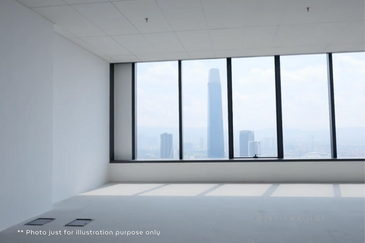
- The RM3.1 billion claim is without interests, while the quantum of RM13.242 billion was calculated with compound interests.
KUALA LUMPUR (March 27): The federal government on Monday (March 27) continued to dispute a private valuer’s valuation of a sum of “mesne profit” over a plot of land in Jalan Duta to be awarded to Semantan Estate (1952) Sdn Bhd, of between RM3.1 billion and RM13.242 billion, by questioning the mode of calculation and comparing it with other comparable properties.
Mesne profits are “the rents and profits which a trespasser has, or might have, received or made during his occupation of the premises, and which therefore he must pay to the true owner as compensation for the tort which he has committed”, according to Jowitt’s Dictionary of English Law.
The property in question in the long-standing dispute that started in the 1960s covers 263.72 acres (106.72 hectares), which encompasses the National Archives, the government offices of the Inland Revenue Board, the Tun Razak hockey stadium, the Segambut roundabout, the Malaysian Anti-Corruption Commission Academy, the Shariah Court, and the Wilayah mosque in Duta.
It was acquired more than 60 years ago in 1956 from Semantan Estate for RM1.32 million. In 2009, the High Court ruled that the government had trespassed on the land, a decision which was overturned by the Court of Appeal in May 2012. However, the Federal Court upheld the High Court's decision in November 2012.
The RM3.1 billion claim is without interests, while the quantum of RM13.242 billion was calculated with compound interests.
Senior federal counsel Mohammad Al-Saifi Hashim, who led the federal government and the Federal Territory land registry, questioned the accuracy of the five-year interval method that valuer CBRE | WTW chairman Foo Gee Jen used to come up with the figures, as compared to doing the valuation annually.
Al-Saifi claimed that the five-year interval method adopted by Foo does not take into account the country's gross domestic product (GDP), the occurrence of the Asian Financial crisis in the 1990s, and other economic factors.
While Foo defended the five-year interval calculation as one that is correct to be used to calculate for longer periods, he agreed that GDP could be one of the factors not taken into consideration in the calculation he used.
The counsel, however, pointed out that the annual GDP showed a steep reduction of 7.4% in 1998, while Foo's calculation showed a 214% growth in rental for that period, which does not reflect this.
Foo, the first witness for Semantan Estate, agreed with the government counsel.
Al-Saifi: You miss some of the events that occurred during that time?
Foo: Agreed.
However, the valuer, when cross-examined by Al-Saifi, still wanted to defend the five-year interval method that his firm used, but was stopped short of doing so as the judge cautioned him to just answer whether he agreed or disagreed with the counsel.
Al-Saifi: I put it to you that the one-year interval adopted by the Valuation and Property Management Department (JPPH) is more consistent and precise?
Foo: I want to explain.... I disagree.
Judge Datuk Ahmad Shahrir Mohd Salleh said Foo can explain when he is re-examined later.
Comparable questioned
Earlier, the government’s representative questioned Foo and his firm about using 21 properties as comparable with the said land on Jalan Duta.
Foo agreed with the government’s counsel that these properties he used in comparison are located at Sungai Buloh, Petaling and Klang, and that they may not be the best comparable plots in terms of location.
However, the witness defended his findings on properties based in Kenny Hills, Bukit Tunku and also Mont Kiara as accurate.
This is despite the said properties in Kenny Hills and Bukit Tunku being residential bungalow lots, while the ones he used from Mont Kiara included those allegedly not a done deal (in sales) yet.
The witness also said he knew there were several restrictions imposed on the development of the disputed land, including a limit on its height.
Foo will continue to be cross-examined by the government counsel and then re-examined by the plaintiff's lawyers on Sept 18, while two officers from JPPH — which are the government’s witnesses — would testify for the defendants from Sept 18 to 20.
In overturning the Court of Appeal's decision in 2012, the Federal Court ruled that the government had trespassed on the land as it acquired the parcels in 1956 under the then Land Acquisition Enactment for the purpose of developing a diplomatic (duta) enclave.
Subsequently, on Nov 22, 2018, the Federal Court, led by Court of Appeal president Tan Sri Ahmad Maarop, dismissed the government's application to review the November 2012 decision by upholding the decision that the government had trespassed on the land.
Semantan Estate claimed it retained its beneficial interest on the 263.27 acres of land in Mukim Batu, which it alleged that the government had taken unlawful possession of, and that the government should pay the company mesne profits as damages for trespassing, with the said damages to be assessed by the court.
It filed a judicial review in 2019 to reacquire the disputed land, but this was dismissed by the High Court. The Court of Appeal is scheduled to hear Semantan Estate's appeal on this on May 10.
TOP PICKS BY EDGEPROP

S2 HEIGHTS(SEREMBAN 2)
Seremban, Negeri Sembilan

LSH33 ( Laman Seri Harmoni )
Sentul, Kuala Lumpur

M Adora @ Wangsa Melawati
Wangsa Maju, Kuala Lumpur

M Adora @ Wangsa Melawati
Wangsa Maju, Kuala Lumpur

Sunway Rydgeway Puncak Melawati
Taman Melawati, Selangor

Kenwingston Platz Residence
Setapak, Kuala Lumpur

Henna Residence @ The Quartz
Wangsa Maju, Kuala Lumpur

M Adora @ Wangsa Melawati
Wangsa Maju, Kuala Lumpur

M Adora @ Wangsa Melawati
Wangsa Maju, Kuala Lumpur

The Ridge @ KL East (Residensi Rabung KL Timur)
Setapak, Kuala Lumpur















